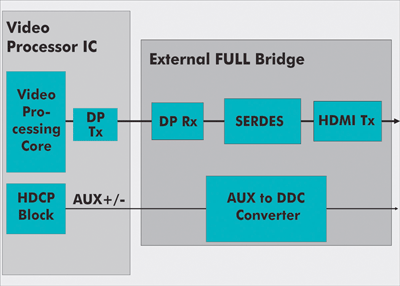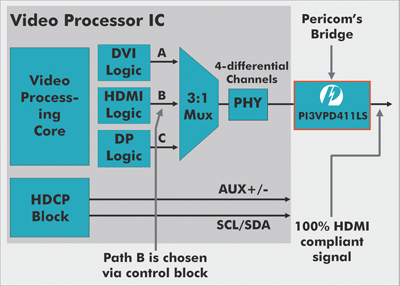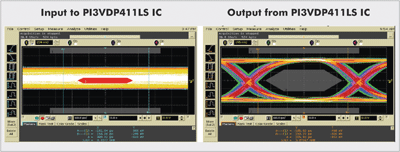DisplayPort standard eases computer display interface
DisplayPort I/O is driving down costs of computer/laptop displays
BY ABDULLAH RAOUF
Pericom
San Jose, CA
http://www.pericom.com
The evolution of digital video has driven the need for new standards that can accommodate greater display resolution, quality, and refresh rates. The dominant technologies in the move to digital display interfaces were HDMI (High Definition Multimedia Interface) and DVI (Digital Video Interface), standards which have entrenched themselves in a wide range of consumer electronics applications. However, both HDMI and DVI are based on Transition Minimized Differential Signaling (TMDS) technology which limits their efficiency and cost-effectiveness when used in LCD monitors and panels for desktop and laptop computers because of the scalar and LVDS drivers required to drive the monitor panels.
As a result, PC and display manufacturers are moving towards general deployment of the new DisplayPort standard put forth by the Video Electronics Standards Association (VESA). The primary reason for the shift is DisplayPort’s ability to directly drive the panel in a manner similar to the old analog-based monitor. Direct drive eliminates the need for high-cost scalars, a significant contributor to system cost in HDMI- and DVI-based monitors and displays. The elimination of scaling circuitry also enables production of extremely low profile monitors as thin as ½ inch—a key differentiating feature with consumers.
However, the DisplayPort interface is not limited to the PC market; by 2010, it is expected to have reached into the consumer market, with penetration into digital televisions. Additionally, its high bandwidth, coupled with low power consumption and low pin count, make it an excellent contender for use as an internal interconnect, as well as box-to-box.
Adoption from the inside out
Certainly, monitor manufacturers are eager to capitalize upon the cost savings and additional capabilities enabled by DisplayPort. Adoption of DisplayPort, however, is also being driven from the inside of the PC.
Graphics chipset companies are using smaller process technologies to minimize die size, power consumption, and cost. Smaller process technologies, however, introduce their own limitations. For example, at 45 nm standard transistors can only support up to a 2.5 V maximum swing, which imposes a critical design constraint for HDMI and DVI since they require 3.6 V for high-speed signals and up to 5.25 V for low-speed side band signals. Chip architects have the option of specialized and proprietary design measures to overcome voltage swing limitations, but only by increasing chip complexity, size, and cost. Moreover, these measures would need to be applied to the whole die, including the main graphics circuitry, raising not just the cost of the interface, but the entire chip. As a result, neither HDMI nor DVI can be cost-effectively integrated into architectures migrating to a 45 nm process.
The high-speed electrical signals used in a DisplayPort interface, on the other hand, never rise above 2 V. All three of the major graphics companies – Intel, AMD/ATI, and nVidia, – have graphics chip sets in development or already available with native DisplayPort interfaces. With both chip-set and monitor manufacturers behind the standard, DisplayPort is clearly the future interface of PC displays.
Bridging the gap between TMDS and DisplayPort
Even with its broad industry support, the difference in life cycle between computers and displays will create a lag in native DisplayPort support in monitors – consider the extended lifetime expected of a high-end projector. During the shift to DisplayPort, therefore, system manufacturers need a simple, low-cost means for providing DisplayPort-enabled PCs and laptops to operate with legacy HDMI and DVI-based displays. In order to maximize performance and quality while controlling cost, developers need to consider where electrical conversion of the signal between interfaces will take place, how to maintain signal integrity, and how to ensure that the proper level of ESD protection is available.


Fig. 1. Combined DisplayPort and HDMI/DVi interface architectures can simplify the overall signal path and provide flexibility.
As discussed above, graphics chip set manufacturers will not be able to fully support HDMI or DVI in their next-generation 45 nm devices. Figure 1a shows an architecture where a DisplayPort-only interface is implemented on the graphics chip set, followed by a full bridge converting the electrical and protocol components of the signal to HDMI or DVI. Full bridges, however, significantly increase system cost since both the electrical signal and protocol must be processed and converted.
Digital interfaces, however, are comprised of both logical/protocol and physical/electrical aspects. As logical/protocol processing does not require high voltage transistors, HDMI and DVI protocols can, and will be, supported in graphics chip sets without limiting the overall architecture or process technology used. Through the use of a multiplexer (see Fig. 1b ), the graphics chip set video driver will be able to produce the protocol for DVI, HDMI, and DisplayPort. The electrical signal, however, in each case will follow the DisplayPort specification.
This approach greatly simplifies the overall signal path and offers more flexibility. If the graphics chip set is to drive a native DisplayPort monitor, both the electrical signal and protocol are correct. If either DVI or HDMI are required to drive a legacy monitor, a partial bridge before the monitor can convert the DisplayPort signal carrying the HDMI/DVI protocol into the appropriate HDMI/DVI signal. Such architecture supports all display interfaces without requiring changes in PC or display designs.
This partial bridge can be implemented in a few ways. It can be implemented on a PC motherboard to offer a TMDS connector directly from the PC. This architecture offers the most reliability, but this limits the system to supporting only HDMI or DVI. Bridging implemented in a cable adapter offers the most flexibility, enabling laptop and desktop users to connect to existing HDMI- and DVI-based monitors as well as DisplayPort-based monitors once they become available. Bridging can also take place in a docking station, but given the long life cycle of this market, cable adapters are likely a more attractive option.
Performance and protection
A performance advantage of using a partial bridge is not having to convert the interface protocol, which minimizes latency and jitter. The bridge can also improve signal quality and provide higher eye margin through well-understood signal enhancement technologies. For example, jitter arising from the distance between the graphics chip set and bridge can be eliminated through equalization while pre-emphasis can be added to the signal to drive the monitor over longer distances and across additional connectors (see Fig. 2 ).

Fig. 2. A partial bridge interface circuit can improve signal quality.
While it may first appear that a bridge introduces an additional component into the signal chain as well as associated noise and losses in signal quality, this is not the case. Consider that all exposed interfaces must be protected against electrostatic discharge (ESD). According to the HDMI specification revision 1.3, displays require 8,000-V ESD protection at the interface connector. Because of the potential damage a chip containing ESD circuitry may sustain, it is undesirable to implement ESD protection in a component such as the graphics chip set that is difficult or even impossible to replace. For this reason, the ESD circuit is typically implemented as a separate component or is integrated with a more accessible component. The Pericom interface IC combines the bridge and ESD circuit, providing the necessary protection without increasing the number of components in the signal path.
Over time, as native DisplayPort monitors become established in the market, there will be less need to connect to legacy HDMI- and DVI-based monitors. In the interim, employing external bridges for electrical conversion provides the most cost-effective means for supporting all display interfaces without requiring architectural redesign and while still leveraging the cost and performance advantages of smaller process technologies. ■
For more on display interfaces, visit http://electronicproducts-com-develop.go-vip.net/digital.asp.
Advertisement
Learn more about Pericom Semiconductor





